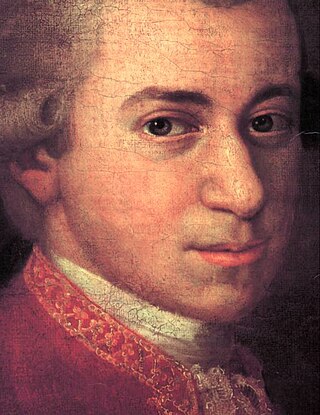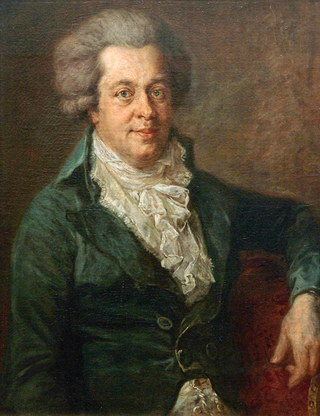
The Violin Concerto in D major, Op. 61, was written by Ludwig van Beethoven in 1806. Its first performance by Franz Clement was unsuccessful and for some decades the work languished in obscurity, until revived in 1844 by the then 12-year-old violinist Joseph Joachim with the orchestra of the London Philharmonic Society conducted by Felix Mendelssohn. Joachim would later claim it to be the "greatest" German violin concerto. Since then it has become one of the best-known and regularly performed violin concertos.

The Bassoon Concerto in B-flat major, K. 191/186e, is a bassoon concerto written in 1774 by Wolfgang Amadeus Mozart. It is the most often performed and studied piece in the entire bassoon repertory. Nearly all professional bassoonists will perform the piece at some stage in their career, and it is probably the most commonly requested piece in orchestral auditions – it is usually requested that the player perform excerpts from the concerto's first two movements in every audition.

The Violin Concerto No. 5 in A major, K. 219, often referred to by the nickname "Turkish", was written by Wolfgang Amadeus Mozart in 1775, premiering during the Christmas season that year in Salzburg. It follows the typical fast–slow–fast musical structure.

Wolfgang Amadeus Mozart's Oboe Concerto in C major, K. 314 (271k), was composed in the spring or summer of 1777, for the oboist Giuseppe Ferlendis (1755–1802) from Bergamo. In 1778, Mozart re-worked it as a concerto for flute in D major. The concerto is a widely studied piece for both instruments and is one of the most important concertos in the oboe repertoire.

Wolfgang Amadeus Mozart's Piano Concerto No. 12 in A major, K. 414 (385p), was written in the autumn of 1782 in Vienna. It is scored for solo piano, two oboes, two bassoons (optional), two horns, and strings. Like all three of the early Vienna concertos that Mozart wrote, it is a modest work that can be performed with only string quartet and keyboard. As per 18th century performance practice a string orchestra could also have served as a suitable option for the "quattro" accompaniment.

The Piano Concerto No. 22 in E♭ major, K. 482, is a work for piano, or fortepiano, and orchestra by Wolfgang Amadeus Mozart, composed in December 1785.
Violin Concerto No. 4 in D major, K. 218, was composed by Wolfgang Amadeus Mozart in 1775 in Salzburg. The autograph of the score is preserved in the Biblioteka Jagiellońska, Kraków. He seemed to have originally composed it for himself to play, but after leaving the Salzburg Court Orchestra, he changed and updated the concerto for the successor of his position in his orchestra, Antonio Brunetti, to play. It is debatable whether the concerto was above Mozart's level of mastery or if he purposely made the concerto difficult for Brunetti on account of his greater ability. The first movement is nicknamed the “military” Mozart Concerto while the second movement consists of melodic lines. The third movement is joyful and full of fun.

←

Mozart's Piano Concerto No. 11 in F major, K. 413, was the second of the group of three early concertos he wrote when in Vienna, in the autumn of 1782. It was the first full concerto he wrote for the subscription concerts he gave in the city. The autograph is held by the Jagiellońska Library, Kraków with an additional, now incomplete, copy that Mozart brought to Salzburg in 1783, in the library of the Archabbey of St Peter's, Salzburg. The concerto is in the usual three movements:
- Allegro in 3
4 - Larghetto in 4
4 - Tempo di menuetto in 3
4

The Serenade No. 10 for winds in B-flat major, K. 361/370a, is a serenade by Wolfgang Amadeus Mozart scored for thirteen instruments: twelve winds and string bass. The piece was probably composed in 1781 or 1782 and is often known by the subtitle Gran Partita, though the title is a misspelling and not in Mozart's hand. It consists of seven movements.
The Quintet in E♭ major for Piano and Winds, K. 452, was composed by Wolfgang Amadeus Mozart on March 30, 1784 and premiered two days later at the Imperial and Royal National Court Theater in Vienna. Shortly after the premiere, Mozart wrote to his father that "I myself consider it to be the best thing I have written in my life." It is scored for piano, oboe, clarinet, horn and bassoon.

Wolfgang Amadeus Mozart's Horn Concerto No. 1 in D major, K. (412+514)/386b was written in 1791. The work is in two movements. Unusually, each movement received a distinct number in the first edition of the Köchel catalogue:
- Allegro 4/4
- Rondo (Allegro) 6/8

Wolfgang Amadeus Mozart's Horn Concerto No. 2 in E-flat major, K. 417 was completed in 1783.

Wolfgang Amadeus Mozart's Horn Concerto No. 4 in E-flat major, K. 495 was completed in 1786.

The Piano Concerto No. 15 in B♭ major, KV. 450 is a concertante work for piano and orchestra by Wolfgang Amadeus Mozart. The concerto is scored for solo piano, flute, two oboes, two bassoons, two horns, and strings. A brief section of the third movement is heard in a transitional scene of the movie Amadeus.

It is not known when Mozart completed his Concerto for Two Pianos and Orchestra in E-flat major, K. 365/316a, but research by Alan Tyson shows that cadenzas for the first and third movements are written in his and his father's handwriting on a type of paper used between August 1775 and January 1777. However, most sources, including Tyson's book Mozart: Studies of the Autograph Scores or more recently Lindeman's The Concerto: A Research and Information Guide (2006) indicate that it was composed in 1779. It is presumed that Mozart wrote it to play with his sister Maria Anna ("Nannerl"). Years later he performed it in a private concert with pupil Josepha Barbara Auernhammer.
Wolfgang Amadeus Mozart's Rondo in B♭ for Violin and Orchestra, K. 269/261a, likely was composed between 1775 and 1777 as a replacement finale for the Violin Concerto No. 1, K. 207.
The bassoon repertoire consists of pieces of music composed for bassoon as a principal instrument that may be performed with or without other instruments. Below is a non-exhaustive list of major works for the bassoon.
The Cassation in D major, K. 100/62a is a composition for orchestra by Wolfgang Amadeus Mozart. It was composed in Salzburg in 1769, along with two other similar works, K. 63 and 99. It is set in eight movements.








